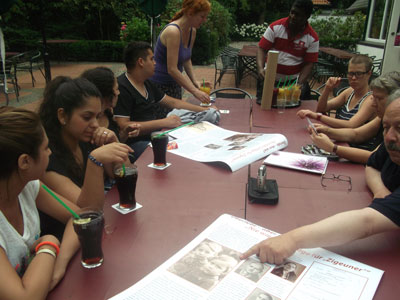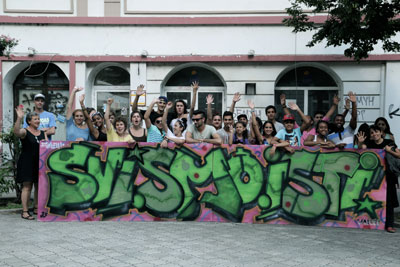By Katrin Schnieders
In 2013 and 2014, 50 youths and 12 adult Roma and friends from three countries took part in the transboundary project "Stars – Going Beyond Borders." The tri-national project was conceived, organized and carried out by the associations Balkanbiro e.V. (Münster), L’artichaut (Marseille) and Vakti – it’s time! (Belgrade). Participants grappled with marginalization, escape, deportation and the fears associated with these conditions. The project included two encounters between young Roma and friends from Germany, Serbia and France. The youth talked about experiences of discrimination related to their (cultural) backgrounds and probed their memories, coached by a trainer.
The project included artistic, social and cultural elements, using video, dance and theater. By talking with contemporary witnesses, seeking out traces of the past and grappling with the culture of commemoration, participants also considered underlying historical conditions. The results, documented in photos, videos and audios, were used in educational workshops on discrimination.
The preparation of the project concept tapped into knowledge about (media-) pedagogy, sociology and social-policy as well as intercultural pedagogy and partnership-based neighborhood projects. The topic "being Roma" was a guiding theme throughout the 12-day program and addressed the realities of life as a member of a minority group. Here, the team relied on substantial work on concepts of "cultural diversity" and anti-racist educational work.

The elaboration on the topic was almost exclusively in the hands of the adult Roma participants, whose life experiences had an empowering effect on others. The manual "Antiziganismus" provided helpful support on approach and methodology. In order to support group dynamics and enable participants to get to know one another, the organizers designed a balanced program that included recreational activities (swimming, barbecue, canoeing…) along with content-related workshops.
Workshops
In addition to workshops on discrimination, there were elective workshops (dance, theater and video/media). These options were introduced to the young participants at the beginning of the week. Content-related topics that arose during the program were taken up, explored further and dealt with using artistic means.
Method: Theater
Among those running the Münster workshops were a theater teacher, a media trainer and a dancer. Lisa Kemme relied on Augusto Boal’s forum theater method: The youths reenacted their experiences on stage and the public could intervene and change situations or suggest possible solutions to a problem. This method strengthens self-esteem and demonstrates opportunities for intervention against discrimination.
Method: Dance
The dance group worked similarly: Participants chose a particular situation of discrimination, expressed it forcefully using body language, and then choreographed a dance. The second encounter in Belgrade enabled participants to collaborate with the city’s performance group "Roma Sijam," which won fame in part through the Serbian version of the X-Factor casting show. The entire workshop team in Serbia was staffed with young Roma, whose lifestyle and biographies made them role models for all the participants. In Belgrade, performers from "Roma Sijam" really put themselves and their experiences as deportees from Germany into the workshops: They worked with the youths to develop a professional choreography on the topic "Svi smo isti!" (We are alike!) and turned their varied experiences of discrimination into a performance.
Method: Video
During the first encounter, the video team developed a film script and storyboard that would help them present the project work. The result was the documentary "Grenzenlos werden" ("Becoming boundless") by Thomas Hackholz. In Belgrade, the video team – which I guided together with director Sami Mustafa – developed interview questions and a concept for filmic portraits. In addition, filming was conducted during workshops and the encounter was documented in photos.
Conversations with eyewitnesses
Two youths and one staff member took part in a continuing education program on interviewing eyewitnesses in spring 2013. On the basis of their insights and their integration of media-pedagogical methods, all the conversations and interviews conducted were developed together with the youths. In Münster, the young participants met with Horst Lübke, a local Sinto who is advocating for the rights of Roma and Sinti and their recognition as victims of persecution under the Nazis. A large part of Lübke’s family was murdered in the camps and he himself experienced discrimination as a child in the 1960s in Münster: Some of these experiences had striking similarities with those of Roma youths in Serbia today. The youths also met Leslie (Lazlo) Schwarz, a Hungarian Jew and Auschwitz survivor. With both these eyewitnesses, the youths had intensive and rewarding discussions.
In Serbia, Borka Vasic accompanied the entire group to the former concentration camp Sajmište in Belgrade. Eleven members of her family perished during World War II, some in this camp. Borka Vasic also recalled the post-war period, the Yugoslavian conflict and the living conditions of Romni today in the slums of Belgrade.
The youths also interviewed Stanka Sinani (72) and Sofia Kaplani (75) from the Roma neighborhood of Zemun, asking about the post-war period and various periods of Roma migration, as well as about the establishment and development of the Roma settlement Vojni Put.
Looking back
The fact that youth from three countries and entirely different realities came together for one week, communicated in four languages, lived in close quarters and expressed their enthusiasm for the encounter despite a packed program can be considered a resounding success. Many friendships were formed and many participants recognized – or rediscovered – the Romanes language as something special, a very useful cultural asset. Some Roma youths were astonished at how well they could communicate with Roma from other countries; others learned how important their language is and expressed the desire to become more proficient in it.

In fact, the project’s future orientation functioned not only at the personal level, but also on the content level: Participants took their lessons home. One reported how she intervened in a history class when her teacher failed to mention the extermination of Sinti and Roma during World War II. Another said her self-esteem as a Roma in German society had greatly improved. Two participants wanted to include the experience of this week in their upcoming studies of sociology and anthropology and planned to stay longer in the Roma settlement in Belgrade. Many are keenly interested in continuing the project. The young Roma from Germany and Serbia would also like to visit France for a longer period and learn more about their friends’ ways of life. Since the youths have been exchanging a information and greetings on Facebook for a year already, in a mix of languages, one can deduce that they are interested in long-term contact. Some are apparently even putting a greater effort into learning English, French or German. They have exchanged addresses and arranged visits for the coming year.
Media skills
Some participants discovered new modes of self-expression through the project. By approaching interview techniques step by step, preparing journalistic interviews and making audio field recordings, the youths learned to address the public through media and to present the project’s contents. The films, radio programs and articles help spread the word about the project and anti-discrimination work and offer support to other discriminated minorities. Some youths from Germany are now even showing the films and running workshops at schools. Students receive methodological tips and support from a trained media educator.
Publication of the project results
In June 2014, "Stars – beyond borders" won third prize (worth 500 euros) in the KICK competition sponsored by Münster Public Utilities. The youths received the prize during a major award event. KICK magazine will include a contribution by the youths on the topic of "Roma discrimination." The film about the project – "Grenzenlos werden", or "Becoming boundless" – has been shown to the French and German public several times; since July, the film has been available with Serbian subtitles. Further screenings and submission to film festivals are planned.

